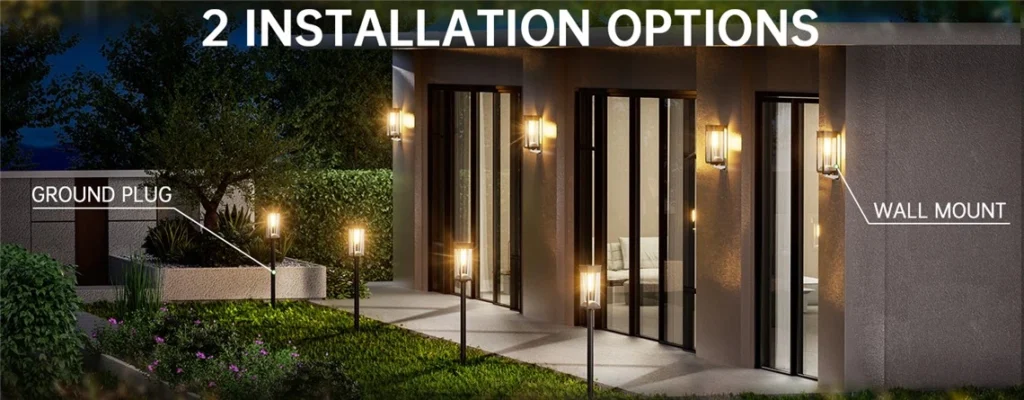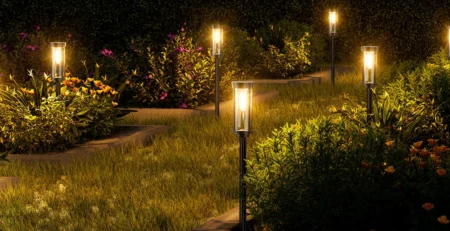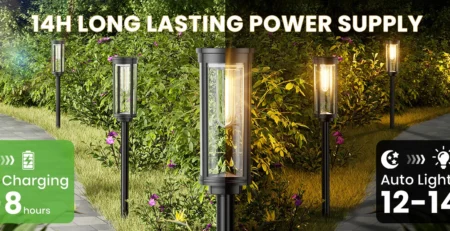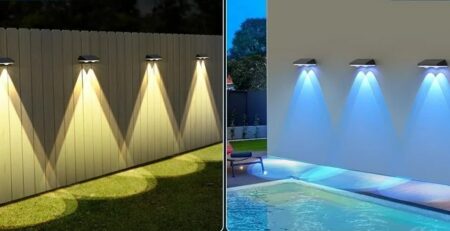Can Solar Lights Join Your Smart Home Network? Exploring the AI Lighting Revolution
Picture this: It’s early morning, and you mumble “Hey Google, sunrise mode” without even opening your eyes. Your outdoor solar lights gradually brighten, mimicking a natural dawn to gently wake the house. At night, they sense your evening dog walk and light your path—smartly dimming on rainy days to save power. Sounds like sci-fi? It’s not—it’s the seamless fusion of solar lights and smart home systems. With the global smart home market surpassing $150 billion in 2025 (Statista data), many wonder: Can these sun-powered eco-warriors truly integrate with Wi-Fi networks and AI hubs?

Don’t worry—this guide breaks it down with Q&A for tech hurdles, real-life examples for practical wins, and future trends to spark inspiration. Whether you’re a smart home newbie or a tech enthusiast, you’ll discover how AI-powered lighting transforms basic solar lights from “yard ornaments” into intelligent home companions. Ready to illuminate the possibilities? Let’s start with the burning question.
Q&A: Solar Lights Meet Smart Homes—Compatibility or Clash?
Ever bought solar lights that felt like lonely islands? No app control, no voice commands—just manual on/off switches? This frustration is common. The core tension? Wi-Fi’s “always-on” power hunger vs. solar’s “intermittent, low-energy” reality. Traditional smart bulbs draw steady wall power for instant Wi-Fi responsiveness; solar lights charge by day and discharge by night, with cloudy days threatening blackouts.
The good news: Bridge tech makes them best friends. Skip direct Wi-Fi (too power-intensive) and use Zigbee, Z-Wave, or Thread protocols—low-energy mesh networks that connect indirectly via a smart hub like Amazon Echo or Apple HomeKit. These act as “translators”: Lights check in hourly, while the hub handles real-time commands. Result? Just 1-2 seconds of lag—way better than fumbling in the dark.
- Key Advantages:
- Zero electricity bills + eco-boost: Save ~200kWh/year per light, cutting 1 ton of CO2 (EPA estimate).
- Scalable ecosystem: One light connects the whole yard—link to doorbells, cameras, and more.
- Real Limitations:
- Weather dependency: Cloudy days cut runtime by 30%; AI helps mitigate.
- Upfront cost: $40–$200 per light (vs. $10 basic ones), but ROI in 1–2 years.
- Beginner Tips:
- Choose hub-included kits (e.g., Ring or TP-Link Kasa solar models).
- Test signal: Keep lights clear of metal obstructions, hub within 50m.
- Winter upgrade: Add “backup battery” modules for double runtime.
Real user story: “My backyard Zigbee solar lights now sync with Home Assistant. Alexa lights them on command—kids play safely at dusk without me flipping switches!” Compatibility solved, the real magic happens when lights start “thinking” like personal assistants.
Unlocking Superpowers: From Basic Glow to AI “Personal Butler”
Forget cheap garden stakes—these solar lights pack sensors and AI chips that make them smarter than your average bulb. Motion sensors evolve beyond “flash and fade”: Machine learning learns your patterns—gentle ramp-up for 8 PM dog walks (no startling the pup), ignoring daytime squirrels. Brightness control? App sliders shift from romantic 10% glow to 100% party blasts with RGB colors, plus auto-adaptive modes that tweak based on ambient light—saving 20% energy.
Timers become “fortune tellers”: Ditch rigid schedules (“on at 7 PM sharp”). AI pulls sunrise/sunset data + weather forecasts for dynamic plans. Rainy tomorrow? It “hoards” daytime charge for an extra evening hour. Key insight: This isn’t feature bloat—it’s “light as a lifestyle extension.” Studies (IEEE 2024) show AI-optimized lighting cuts household energy 15–25%, shining brightest in solar setups.
Everyday Magic in Action (with emoji flair):
- 🌅 Morning Wake-Up: Lights + curtains sync for gradual dawn simulation—ditch harsh alarms.
- 🛡️ Nighttime Security: Motion triggers yard-wide flood + app alerts for strangers.
- 🎉 Party Vibes: Voice-activate “disco mode” for beat-synced RGB pulses.
- 💡 Energy Ninja: AI spots low-use times, auto-dims to stretch battery life.
Fun fact: They can’t read minds, but they nail your “lazy mode”—no ladder climbs for rainy-day recharges; AI “hibernates” intelligently. Curious how this lands in real products? Brands like Bitpott are leading the charge.
Bitpott’s Game-Changers: Solar + AI “Black Tech” Fusion
Among the crowd, Bitpott stands out—not just compatible, but reinventing solar DNA. Their SolarAI series embeds neural network chips that “learn” during daylight charging: sunlight patterns, battery health, even local temps. Outcome? 50% smarter automation than rivals.

Standout Innovations:
- Smart Charge Forecasting: App warns, “Cloudy ahead—top off manually tonight” to dodge dark surprises.
- Swarm Control: Zone 10+ lights—one tap for “front yard security” vs. “backyard chill.”
- Universal Fit: Native Matter protocol (2025 standard) for one-click Apple/Google/Samsung harmony.
User testimonial: A city gardener revamped their balcony: “Winter lights lasted 4 hours before; now AI ‘stocks up’ for 8, syncing with grow lights. Plants thrive—my space feels alive!” Drawback? Affordable ($60+), but premium AI needs solid signal.
Why Bitpott shines: It flips solar from “passive power” to “active brain”—lights feed data back (e.g., “Sunny today—skip AC to save energy”). Users evolve from “controlling lights” to “lights optimizing life.”
User Lens: Voice + App “Lazy Luxuries” in Daily Life
Tech is only as good as it feels. Solar smart lights win with zero-learning-curve integration. Voice commands are effortless: “Alexa, goodnight” fades lights, locks doors, arms security. App control adds finesse: Map-based drag-and-drop—”Boost backyard purple for the BBQ.”
Scheduling smarts: AI studies your week—full blast for Monday meetings, lazy weekends auto-delayed. A working mom’s routine:
- 6:30 AM: Lights + blinds for kid-friendly wake-up.
- 7 PM: Motion-guided dog walks with path lighting.
- Late night: Low-power standby, instant alerts for odd activity.
Pain Points Crushed:
- Winter battery blues? AI prioritizes key zones first.
- Device chaos? Single app bridges everything—no app-switching hell.
Per Consumer Reports 2025, 80% of users report “major convenience gains,” especially outdoors (garages, patios). But this is just the start—AI’s future holds predictive powers.
AI Horizon: Weather Oracles + Energy Brains for Next-Gen Lighting
Solar lights’ ultimate leap: From reactive to prophetic. Future AI taps real-time weather APIs + satellite feeds for “fortune-telling”: Storm incoming? Pre-charge + evacuation nudge. Time-adaptive glow: Holiday mode shifts to festive colors; circadian rhythms get blue-light boosts for focus.
Energy IQ: Low battery? Tap home grid via microgrids or peer-to-peer neighbor solar sharing. Bold forecast: AI solar lighting market triples by 2027 (Gartner), powered by ML feedback loops—lights self-improve with use. Imagine: Lamp predicts your late shift, pre-lights the “welcome home” path?
Challenges & Wins:
- Privacy: On-device AI processing—no “eavesdropping.”
- Standards: Matter unifies ecosystems.
- Green Impact: Massive carbon cuts—each home saves 1 ton CO2 yearly.
Expert take: “AI solar lights aren’t gadgets—they’re climate micro-solutions. Scale to billions of homes, and it’s the planet breathing easier.”
Wrap-Up: Ignite Your Smart, Green Future—Start Today
Solar lights in smart homes? From ‘maybe’ to must-have. Bridge tech to AI foresight delivers zero-cost, hands-free, eco-smart lighting—illuminating spaces and sustainable paths. Don’t settle for half-smart yards—dive into Bitpott or compatible kits for “thinking lights” magic.
3-Step Action Plan:
- Site Check: 4+ hours daily sun? You’re golden.
- Starter Buy: $50 Zigbee lights, scale to AI.
- Community Hack: Join Reddit r/smarthome for pro tips.
Ready to network your solar lights? Act now—your home gains a “green AI butler” tomorrow. Share your smart lighting wins in the comments—let’s light up more ideas together!











Leave a Reply